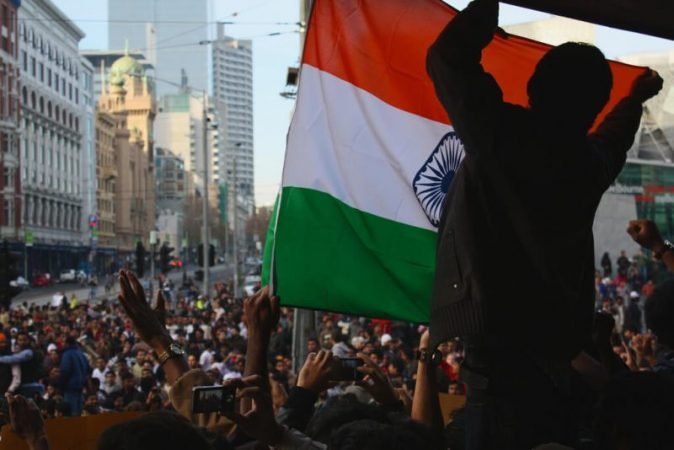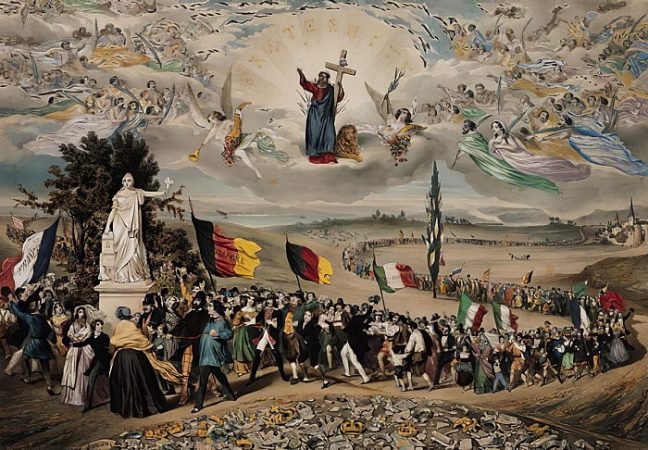Indian Nationalism: Development And Concerns

“Nations are the irreplaceable cells of the human community.”
-Franjo Tudjman
The world we live in is one that is deeply conscious of the importance of giving recognition to identities. Today, we are seeing multiple battles for the legitimacy of group identities, most of which use the language of nationalism. Nationalism has emerged as one of the most convincing political creeds that has helped shape history over the last 200 years or more. Both strong allegiances and profound bigotries have been motivated. It has unified and fragmented citizens helped to free them from authoritarian rule and was the source of strife, resentment and conflicts. Nationalist struggles have contributed to the drawing and the redrawing of the boundaries of states and empires.
In the simplest sense, nationalism is the belief that the nation is, or should be, the most basic principle of political organization. Nationalism is a chameleon-like philosophy capable of taking a multitude of political forms. At different points, it was revolutionary and conservative, egalitarian and repressive, empowering and patriarchal, violent and peaceful, and so forth. It is the vehicle through which national groups have sought to secure their self-determination, in addition to national identity, by institutionalizing the nationalist movement into an independent sovereign nation-state.

India imported modern nationalism from Europe. Nearly, everybody accepts that some two decades after the Mutiny of 1857, real nationalist feelings arose in India. Before the real nationalist feelings could emerge, India had to be united and furthermore, it needed to learn from the historical lessons so profusely provided by the different nationalist movements of Europe like the national unification of France.
At a much prior stage, Bankim Chandra had understood that since one of the fundamental issues of Indian legislative issues was the need of social attachment, it was this that should have been given more attention than maybe patriotism itself. Undoubtedly, an essential to patriotism was the nearby recognizable proof of the person with a specific network and the separation of the enthusiasm of the specific network from different networks. Subsequently, a few of the prior patriot pioneers were seeing union as a piece- feast measure. However, the elements of imperialism itself made conditions for solidarity.
The Indian patriotism was additionally reinforced by the recuperation of India’s past legacy and culture, which was, before the nineteenth century, practically sterile, particularly during the pre-Mogul time. The Hindu patriot pioneers found in the development, a restoration of their legacy and culture. There came a moment that patriotism and Hinduism became equivalent words.
Today when we discuss the Mauryas, the Guptas, the Chalukyas and the Pallavas, let it be recollected that the account of these extraordinary times of Indian history was recouped to us by the works of European researchers in the administration of the British Government in India.

Origins of Nationalist Movement
For the two, Indians and British, the time of the severe Indian revolt of 1857–59 was spooky with dull recollections of the insurrection, and various measures were taken by the British Raj to maintain a strategic distance from another contention.
The Indian National (Congress Party) held its first gathering in December 1885 in Bombay city while British Indian soldiers were all the while battling in Upper Burma. The memorable gathering was held with the objectives to shape the germ of a Native Parliament and to establish in a couple of years a responsible answer to the statement that India is still entirely unsuitable for any type of agent organizations.
Consequently, similarly, as the British Indian domain moved toward its furthest constraints of development, the institutional seed of the biggest of its public replacements was planted. Commonplace underlying foundations of Indian patriotism, in any case, might be followed to the start of the period of crown rule in Bombay, Bengal, and Madras.
Patriotism rose in nineteenth-century British India both in the copying of and as a response against the combination of British guideline and the spread of Western development. There were, in addition, two violent public standards streaming underneath the misleadingly peaceful authority surface of British organization: the bigger, headed by the Indian National Congress, which drove in the end to the introduction of India, and the littler Muslim one, which gained its authoritative skeleton with the establishing of the Muslim League in 1906 and prompted the formation of Pakistan.
The viceroyalties of Lytton and Lord Ripon (represented 1880–84) arranged the dirt of British India for patriotism, the previous by interior proportions of suppression and the uselessness of an outer approach of animosity, the last by implication because of the European people group’s dismissal of his liberal compassionate enactment.

Post World War I
By Armistice Day, November 11 1918, in excess of a million Indian soldiers had been transported abroad to battle or fill in as non-warriors and almost 150,000 fight losses, more than 36,000 of them lethal, were continued during the war. India’s material and budgetary commitments to the war exertion incorporated the shipment of huge measures of military stores and gear to different fronts and almost 5,000,000 tons of wheat to Great Britain.
Strategically, the post-war years demonstrated similarly discouraging and baffling to India’s extraordinary desires. Indian warriors additionally came back from battlefronts to locate that back home they were not, at this point treated as important partners however returned quickly to the status of “locals”. Most of the officers selected during the war had originated from Punjab, which, with short of what one-tenth of India’s populace, had provided the same number of as half of the soldier troops dispatched abroad. It is in this way scarcely astounding that the glimmering purpose of post-war brutality that shook India in the spring of 1919 was the Punjab region.
On a Sunday evening of April 13 1919, when many neighbouring town workers had come to Amritsar to praise the spring Baisakhi celebration, Dyer situated his men at the sole, slender path of the Bagh, and without giving any expression of caution, he requested 50 officers to fire into the get-together. About 400 regular people were executed, and another 1,200 were left injured with no clinical consideration.
The Massacre of Amritsar diverted a great many moderate Indians from understanding and steadfast supporters of the British raj into patriots who might never again put trust in British “reasonable play.” In this way, it signifies the decisive moment for a significant number of the Congress’ backers of moderate cooperation with the Raj and its expected improvements to progressive non-participation.
Apparently, patriotism in the twentieth century has been a significant power in the battle of commanded and abused people groups to topple the unfamiliar standard. Be that as it may, simultaneously, harmony, success, and opportunity have not naturally practised public freedom.
In proclaiming war on Nazi Germany, the Governor-General, however inside his lawful rights, settled on a fairly perilous choice in not counselling the regularly developing patriot powers in India. A Bill was presented and gone in the British Parliament which changed the Constitutional Act of 1935 so as to empower the Government of India to utilize uncommon forces, if and when fundamental, to assemble the war endeavours both at the Central and commonplace levels.
The Indian National Congress responded enthusiastically to this alteration of the Act which was driving them toward inevitable self-rule. They saw this measure to be planned for checking the commonplace self-sufficiency and making fascism rather than the popular government in India. Following the announcement of war, the Government of India started a mission to charm the Indian National Congress, the Muslim League and the Princely States. The intention was to look for their participation in the war.
Obviously, the Congress was eager to help out the British war endeavours given that the British explained what they would do with respect to India’s autonomy after the war. The British Government in India, be that as it may, was not ready to submit itself about the post-war established status of the country. Thusly, the Congress governments in the territories gave over their acquiescence to the Governors before the finish of October 1939.
In August 1940, the British Government made a declaration known as the “August Offer”, as per which the ‘Administration wanted to extend the Governor-General’s Council. The Congress dismissed Government’s “August Offer”, and the hole between the two got more extensive than any time in recent memory. From that point, the pioneers of the Indian National Congress embraced an enemy of the British mission. Solid words were verbally expressed. Before long numerous Indian patriots started their common rebellion. Accordingly, conspicuous pioneers were captured and imprisoned.

Toward the end
This was the beginning of something important, and the pre-Independence history of India started to unfurl. Six significant classes of the scene that completely spread the established imply that in the long run prompted India’s autonomy are: Congress’ Quit India Resolution, the Wavell Plan, the Cabinet Plan, the Cabinet Mission Plan, the Mountbatten Solution, lastly, the Indian Independence Bill, 1947.
This brought about the finish of the long street to India’s freedom. In spite of the fact that there were numerous explanations behind Britain’s withdrawal from India that were chronicled and conditional in nature it is additionally evident that as patriot sentiments alongside communalism increased, the British rushed to locate the last arrangement. That arrangement was protected in nature, bringing about the making of two territories, India and Pakistan.
India is an enormous nation. Its administration has consistently been a difficult undertaking. Be that as it may, nothing was more repetitive than the assignment of dividing it. To execute the parcel of a nation of 400 million individuals and achieve the exchange of capacity to two Dominions in around ten weeks was not simple. However awful, it was the most critical event in the whole history of Indian patriotism. Finally, India got up to life and opportunity.
Everything considered a couple of definite assessments of the cycle can be made. In such manner, one can’t avoid the way that the English-taught Indian world-class reacted overwhelmingly to the call for self-rule on account of their verifiable duty for the Anglo-Saxon political foundations for India. The Indian patriotism that at last had a huge effect and head start was basically sacred. It is contended that in settlements, for example, India, with English-instructed white-collar class, the direction got by the British supporters in any event in the developmental periods of patriotism, coordinated the battle for freedom a protected way.



















